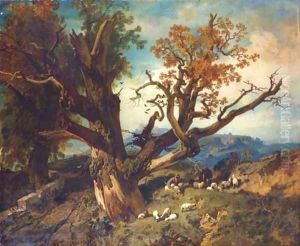School Of Barbizon Paintings
The School of Barbizon was not a formal school but rather a group of like-minded painters who gathered in the village of Barbizon, France, near the Forest of Fontainebleau, from the 1830s to the 1870s. This movement marked a significant shift in the landscape painting tradition, emphasizing natural scenes and the direct observation of nature. The Barbizon School was crucial in the development of landscape painting and served as a precursor to the Impressionist movement, advocating for painting en plein air (outdoors) long before it became a staple of Impressionist practice.
The artists associated with the Barbizon School sought to capture the beauty, variability, and transient effects of the natural landscape. They were particularly interested in depicting rural and forest scenes, aiming to convey the mood and atmosphere of the countryside rather than idealized or historical landscapes that had dominated French painting. Among the key figures were Jean-François Millet, Théodore Rousseau, Charles-François Daubigny, Narcisse Díaz de la Peña, and Jules Dupré. These artists focused on the everyday life of peasants and the rugged beauty of nature, which they observed firsthand.
Jean-François Millet, for example, is best known for his depictions of peasant farmers; his works such as 'The Gleaners' and 'The Angelus' reflect deep empathy for the rural working class. Théodore Rousseau, often considered a leader of the group, was passionate about the Forest of Fontainebleau and dedicated many of his works to its landscape. Charles-François Daubigny contributed significantly to landscape painting with his innovative use of light and color, which would later influence the Impressionists.
The Barbizon painters were among the first to break away from the classical traditions that dictated art should emulate the ideal forms of ancient Greece and Rome. Instead, they believed that art should reflect the reality of the world around them, particularly the unembellished beauty of nature. Their emphasis on light, shadow, and color, and their preference for painting outdoors directly from the subject, were revolutionary at the time and laid the groundwork for the developments in art that followed.
Though the School of Barbizon was not a formal institution with a specific manifesto, its members shared a common philosophy that profoundly impacted the art world. Their work received mixed reviews during their time, with some critics dismissing their focus on the mundane aspects of rural life. However, their approach to painting and their celebration of the natural world eventually gained widespread recognition and admiration, paving the way for the Impressionist movement and forever changing the course of art history.
